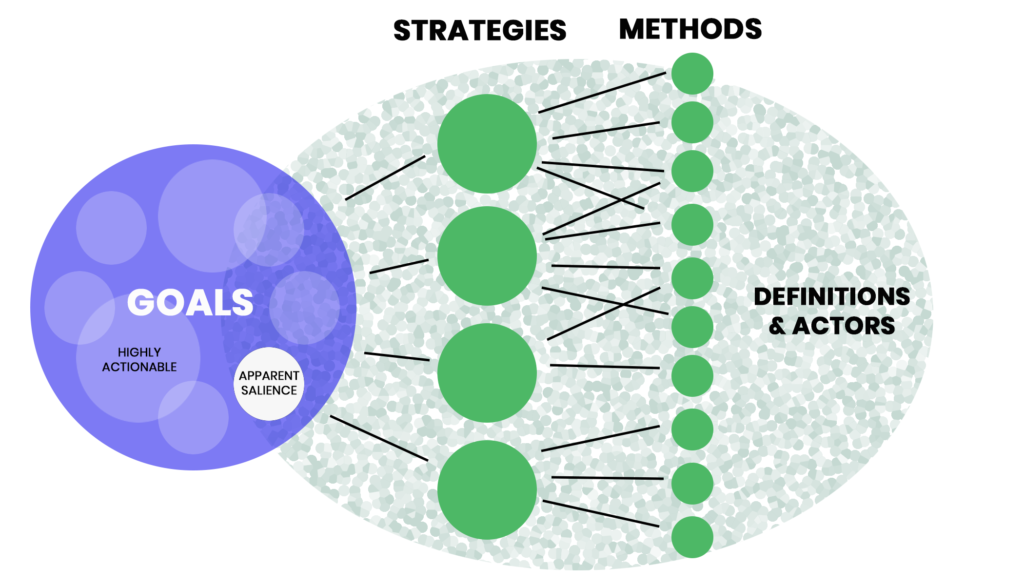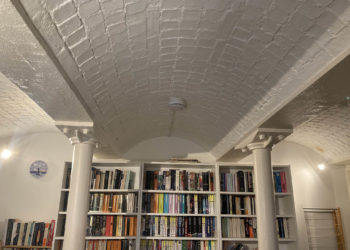Editor’s Note: Today’s post is by Glenn Hampson, Mel DeSart, and Rob Johnson. Glenn is the Executive Director of the Science Communication Institute. Mel is Head of the Engineering Library at the University of Washington. Rob is Founder and Director, Research Consulting.
Regular readers of The Scholarly Kitchen understand that the scholarly communication landscape is a dense thicket of stakeholders, disciplines, perspectives, goals and solutions. For us, it can be difficult — even disorienting — to view this landscape from a higher elevation and notice that the trunks and undergrowth are actually part of a large forest ecosystem. This high vantage is important as our community increasingly debates the future of open access alongside other open solutions like open data and open science. Only a high vantage will be able to reveal the true contours of this landscape and the trails we should traverse.
UNESCO has been exploring this landscape for over 20 years now, supporting a wide variety of open efforts around the world, including the Open Scholarship Initiative (OSI), which since early 2015 has been working closely with and advising UNESCO on the open access challenge. Over 450 senior leaders representing 250 institutions, 30 countries and 20 stakeholder groups have participated in OSI conferences, reports, and online conversations so far, with the goal of trying to develop broad, global, sustainable solutions for the future of open scholarship. In August of 2020, a team of analysts from OSI began exploring an intriguing question posed by UNESCO leaders: Should our current approach to open expand so we don’t look just at one open movement at a time, but at the entire open movement instead?

The trunks and undergrowth
Open access, open data, open science, open source, open educational resources, and open government all have their own separate histories, constituencies and language. As a result, most of our open policies and actions (not just for open access, but for all open solutions), involving many actors from across the ideological, stakeholder and geographic spectrum, are not integrated in any significant way at the global level.
Why does this matter? Aren’t we doing just fine wandering around in our forest? It depends who you ask and how you define “fine”. Some are perfectly happy with our community’s progress to date on open and are confident we’re heading in the right direction. Others have concerns that, especially given the complexities of the road ahead, we need to better understand where we’re going so we don’t get lost or hit dead-ends.
There are limitations to our current vantage, deep in the woods as we are. As Smith and Reilly note in their 2013 work, the open philosophers who have viewed the richness and interconnectedness of open movements from higher ground recognize that openness is a means, not an end. Their advice is to set clear goals as a community, use open solutions to achieve these goals, and make sure we don’t ignore the inequities and unintended consequences caused by our current approaches.
As far as dead-ends are concerned, current solutions and business models are pulling us in the wrong direction, toward a world where only rich institutions and countries will be able to publish in the most widely read open journals. This approach threatens to further disenfranchise yet another generation of researchers from lower-resourced regions of the world, and perpetuate an era of privileged science where the only questions researched are those of importance to the rich. Our current solutions and business models also threaten to fracture the greater cause of open along ideological and regional fault lines.
A river runs through it
There are a number of ways to look at this challenge, of course. Many in OSI have recommended reorienting our thinking so we develop open solutions that are grounded in the actual needs of researchers. Why? After all, some have argued that researchers don’t care about open or are too busy to care.
The answer is three-fold. First and foremost, researchers are the river that runs through our scholarly communication forest. By maintaining a robust and effective research community, the entire forest thrives. Second, researchers do in fact care about open insofar as it can help improve the quality, reach and impact of their work. The linchpin to this approach is that, third, our open efforts to date have mostly reasoned forward from our ideological conclusions about open to our solutions for open, meaning that our open solutions often get presented to the research community as mandates that are insufficiently grounded in need or evidence. We need to reverse our thinking so we better understand needs and evidence first, then proceed to build our open tools and solutions. This will help create open outcomes that are more strongly embraced by research, and more likely to benefit research, which will then spur faster uptake and more investment in even better open tools and solutions.
It’s not news that we need researchers to be more involved in designing the future of open policies, but researcher voices have been underrepresented over the 20+ year-long conversation we’ve had in this community. We have learned a lot over the years about how researchers want their work to make an impact (see “Imagining a Gold Open Access Future: Attitudes, Behaviors, and Funding Scenarios among Authors of Academic Scholarship”, “A survey of authors publishing in four megajournals”, and “Monitoring the transition to open access” for example), and can be confused by open and put off by the work involved in compliance. We’ve also learned that many questions of fundamental importance to researchers — like who open is for, why we’re trying to achieve more open, and what we plan to do with open information — aren’t at all clear.
As a consequence, in our rush to achieve open not only with one-size-fits-all solutions, but also by ascribing one-size-fits-all motivations, we have left behind a large portion of researchers who, for their particular work and needs, are not impressed with open benefits so far, are concerned about the real or potential negative consequences of current approaches to open, or want a more complete understanding of the dynamics in this space before deciding which solutions are best for them.
This isn’t to say that the social justice-oriented missions of open publishers and groups haven’t been clear, but that as a body, researchers subscribe to a very wide variety of motives for open, come from many different schools of thought, and apply many different organizing elements and guiding principles (see here for a broader discussion). Not all researchers (maybe even a minority) are moved primarily by the social justice motive as opposed to more “selfish” motives. As a consequence, in our rush to achieve open not only with one-size-fits-all solutions, but also by ascribing one-size-fits-all motivations, we have left behind a large portion of researchers who, for their particular work and needs, are not impressed with open benefits so far, are concerned about the real or potential negative consequences of current approaches to open, or want a more complete understanding of the dynamics in this space before deciding which solutions are best for them.
The open solutions approach
In exploring UNESCO’s hunch about taking a more forest-centric approach to the future of open, OSI’s latest policy paper* confirms that this approach might in fact be the best way to go. An “open solutions” approach isn’t a mash-up of existing open policies and processes. Instead, this approach embraces the fact that the open forest has many different parts — stakeholders, disciplines, perspectives, goals and solutions — and that the consumers of open knowledge care about accessible, reliable, and usable information, not whether this information is text, data, or code, or comes from a government, university, or industry. Every part of the open forest is important, every input and output is valued, and all of this diversity contributes to the greater whole.
There are several paths to understanding what this open solutions forest looks like (see, for instance, Smith and Seward’s 2020 collection of essays). The most helpful for understanding why open operates the way it does (instead of just cataloging what open does) is the goal-based approach (see figure below). Fundamentally, all open efforts share common goals—the most basic of which is to make information more open. To achieve these goals, many different strategies and methods are employed. In this approach, the diaspora of actors and definitions that surround this activity are just artifacts of the open strategies and methods we employ.

This goals-based approach has much in common with the Theory of Change approach, which identifies the long-term change that is desired, and then works backward to map out the actions and policies needed to create this change. We know this approach works and is already widely used in business and government. The UN’s Sustainable Development Goals are obvious examples of how this focus is already working internationally (see an example here and another example here).
What this means in practical terms
Adopting a goal-centric approach to the future of open solutions policy doesn’t mean we should create only one definition of open, or only one set of open policies, or even reach global agreement on what we should do and how. Rather, it means we should embrace the diversity of the open space, work together more effectively on common goals, and resolve to let the best ideas win. Instead of just collecting open artifacts like we do now and remaining captive to the mindset that open is something a single group owns and can define and legislate, a goal-centric approach means working together in common cause to solve real problems with all kinds of open, letting the free competition of ideas decide which approaches work best, and then helping the community of open users take ownership of these ideas and continuously improve research with open.
The impacts of this approach will vary by field and type of open. We already know, for example, that open comes in many forms. Rather than saying that only one of these forms can be produced (the CC-BY variety, which in survey after survey is the least popular), why not just acknowledge that there’s an open spectrum? We can work together to improve open outcomes over time, but the most important first step is to start thinking in terms of getting information somewhere onto this spectrum — at least discoverable, ideally accessible too, and reusable if possible, but appreciating that outcomes vary.
Open science, open data and open source have similar diversity. Here, too, there are no one-size-fits-all approaches that work everywhere, all the time. Indeed, in open science and open data, some of the most successful “open” models are quite closed — data sharing partnerships that involve a closed set of participants who can only utilize data under strict conditions (see this example or another example here for instance). And in open source, 90% of open code today is written by commercial companies but the public serves a vital role as “product manager”, as they can see the code and help debug it, answer questions from the public, and develop new ideas and applications. These types of open don’t fit our ideological narrative of what open is “supposed” to look like, but they do fit the reality (at least for now) of what robust and sustainable open ecosystems look like in practice.
Common ground
Importantly, any open future should be designed by the entire global research community working together on common ground (as OSI and UNESCO have long advocated). OSI’s Common Ground paper describes one version of this collaborative approach to the future, involving working together to get as much research as possible somewhere onto the open spectrum, improve open outcomes, immediately improve access where it’s most needed, improve open clarity and standards, address urgent needs, pilot open solutions, and design the future of open.
Going forward, what if the global scholarly communication community works together like this, but also takes an open solutions approach? Combining both these philosophies — working together, and also doing so on a unified approach — isn’t essential. Each approach can be supported in its own right. But together, this simplified and unified approach to the future of open is powerful and revolutionary, and more likely to help us reach an Open Renaissance in the near future where open is the norm and the benefits that open creates for research and society can begin to rapidly multiply.
To cynics, this may sound like a call for slowing down the pace of open so it can be controlled by the most conservative and recalcitrant voices in our community. It’s actually the opposite, though: a call to build new bridges for cooperation and collaboration, explore vast new territories of potential collaboration, and chart a course for a type of open that is driven by goals, benefits, and discovery, not just the act of collecting open artifacts. Getting from where we are now to this type of thinking doesn’t require applying brakes, but stepping on the gas. There’s no funding “ask” here, no policy reversals, no appeals to sign a declaration or join a cause, just an intellectual call to arms.
OSI can help get this kind of effort off the ground, but it’s ultimately going to take the active and sustained involvement of lots of heavy hitters across the scholarly communication universe to make this more than just another declaration. As a first step, we need to change our vantage. There is so much more that unites the scholarly communication community than divides it. The sooner we recognize the open forest for what it is, and stop thinking of open as merely a vast assortment of trees and undergrowth, the sooner we can begin building the open future we need and that holds so much potential to change the world.
*This report was written by Glenn Hampson, Mel DeSart, Lynn Kamerlin, Ron Johnson, Hillary Hanahoe, Amy Nurnberger and Chris Graf. As with other OSI reports, this report does not represent the viewpoint of every OSI participant, nor does it represent the official viewpoint of UNESCO. The OSI Policy Perspectives series (of which this report is a part) offers broad, common ground perspectives on key issues in scholarly communication. Each report summarizes the current state of a particular issue and what we know about it, and also attempts to articulate the perspectives and lessons of experience from all stakeholder groups in scholarly communication on this issue (particularly but not exclusively as expressed in OSI conversations) and identify what common ground might exist for building broadly acceptable policy.
Discussion
2 Thoughts on "Guest Post — A Unified, Common Ground Approach to Open"
The social justice element among academics has well-reasoned arguments behind it, many of which are accepted among other colleagues [I know because I am a professor and give talks and write a fair bit on the issue, as well as editing a platinum OA journal]. But the majority of academics choose to ignore those S J arguments when selecting journals to publish in. Either 1) they are forced into uncomfortable journal outlet choices by the academic hiring, promotion and prestige system that still values journals published by the big 5 publishers, or 2) there is a psychological or ethical failure because their sentiments and actions do not match up. The existence of the latter must be a valid phenomena for someone to research, if they haven’t already. It is rather like the conundrum of ‘doctors working on lung disease who smoke’, or ‘engineers who design recycling tech who throw all trash in the same bin that goes to landfill’. Or ‘concerned climate scientists who drive a gas guzzling V8’. I have puzzled over these sorts of mismatches for decades, and should probably turn to the literature in psychology, which is not my field. I work with ‘social scientists highly critical of capitalism who publish most of their work with the big 5 commercial publishers’. How do we explain this, unless fear of 1) is present in every decision made under 2)? If so, we have no social justice.
Hi SP—sorry that I’m only now seeing your comment. You’ve put your finger on a common refrain, which, as luck would have it, Dustin Fife speaks to in his May 5th TSK post, “Space and Grace in Open Access Publishing” (https://bit.ly/33kQ9fm). What might also help think through this thicket is to realize that open has a wide variety of motives—not just SJ, but cost, speed, higher visibility, mandates, and more. Many (maybe even most?) researchers aren’t moved by the SJ argument, or at least they aren’t moved as much as they are by the need to create impact. In survey after survey, researchers want to make sure their work reaches the right audience and has the most impact on research and society. So, to the extent that open can align with these incentives, that’s a win-win. But should researchers trade research impact for SJ? Most researchers would say no.



